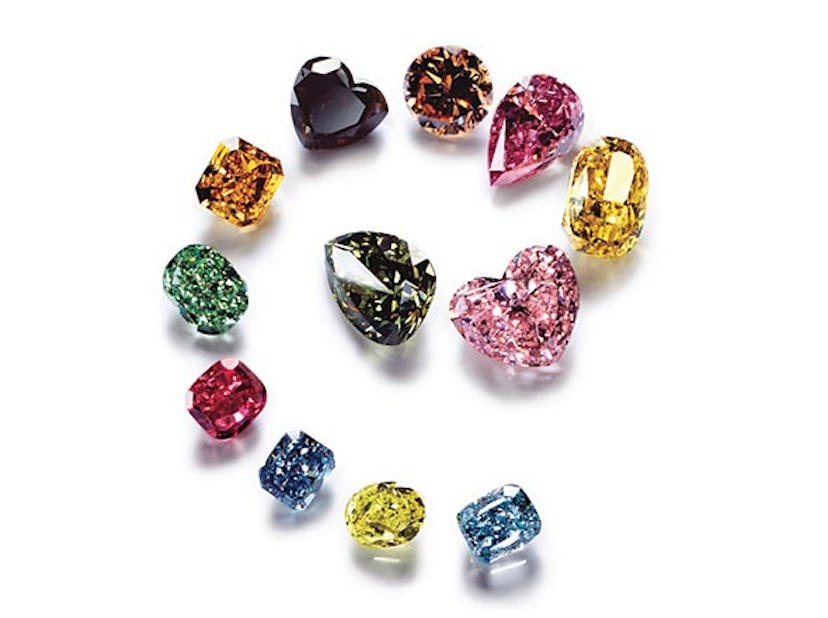Color Wheel

Diamonds may be a girl’s best friend, but the luckiest gals on the block are the ones with rocks in shades of yellow, pink and blue. Colored diamonds are attracting more attention than ever, spurred by celebrity purchases, explosions of wealth in China and Russia, and the general desire to own the exceptional. “It’s not just happening in jewelry. It’s happening in art; it’s happening with anything that is one of a kind,” says Henri Barguirdjian, the president and chief executive officer of Graff in America. “All around the world, a very affluent clientele is seeking and collecting rare things. And colored diamonds are on top of the list.” For those just finding their footing in the rarefied world of colored diamonds, W offers a primer, from the mines that matter to the most coveted shades under the sun pullquote: One of every 10,000 diamonds mined is a color other than white, and each has its own raison d’être.
What’s What Diamonds form and surface over millions of years when carbon comes under high levels of pressure and temperature; naturally occurring colored diamonds get their hue from unusual chemical compositions. One of every 10,000 diamonds mined is a color other than white, and each has its own raison d’être. Yellow diamonds, for example, occur when nitrogen atoms replace some carbon atoms in the formation process. Blue diamonds benefit from too much boron, and green diamonds sparkle thanks to natural radiation. It’s thought that pink diamonds occur because of a certain type of blemish known as graining, the presence of lines within the stone that signify an altered structure. Though colored diamonds can occur in any mine that produces white diamonds, certain locales, such as the Argyle Mine in Australia, known for its pink and champagne stones, are famous for producing specific colors.
Color Coding Naturally colored diamonds are classified according to their intensity and exact shade. Yellow and brown diamonds can be classified on the normal letter grading scale (D to Z), but when their hues become more intense, they become fancy colored diamonds. So, too, do diamonds exhibiting all other colors. Fancy colored stones are graded on a sliding scale with hues that range from light to vivid, with vivid stones having the most saturated and highly prized color. But, says Sotheby’s Diamonds vice president Naval Bhandari, “You can’t really say that the higher the grade, the nicer the stone. You might prefer the fancy color [to the fancy intense], so beauty is in the eye of the beholder.”
Fancy brown, gray and black diamonds are the most price friendly, followed by fancy yellow, orange and olive, then pink, blue and green. The rarest and most expensive of colored diamonds come in pure shades of purple or red and can easily garner $1 million per carat, though it’s nearly impossible to find a purple stone that exceeds a carat. One of the largest known red diamonds in the world, the Moussaieff Red Diamond, clocks in at just over five carats.
Of course, diamonds also come in a blend of these shades. A stone can be purplish pink, pinkish purple or purple-pink, which means there is an even distribution of both colors. A quirky cousin of the colored diamond is the chameleon, which changes from an olive green to golden yellow when exposed to heat or specfic types of light.
While it’s commonplace to treat certain stones, like emerald or blue topaz, with oil, heat or irradiation to enhance their color, the most desirable colored diamonds are naturally occurring and untreated. The exception to the rule is the black diamond, which acquires its deep color from the high number of inclusions present in the stone. To bring out a more even hue, black diamonds are commonly irradiated.
Shape Shifters The shapes that show off color best are radiant, oval and pear. “The light is able to travel through [those shapes] at a slower rate,” explains Bhandari, noting that it thereby produces a more intense viewing experience. A round diamond, by comparison, “is designed to draw in light, reflect and refract it right back to your eye.” Though colored diamonds can be cut into round, emerald and princess shapes, they don’t hold color as well, and in many cases, “they’ll actually demand a premium in the marketplace because you need much stronger, much better [raw] material in order to get the same quality stone,” notes Jordan Fine, vice president of Amgad, a cutter and wholesaler of colored diamonds.
Size Matters Women who long to wear massive chunks of ice on their fingers should stay away. Because fancy colored diamonds can rarely be found in double-digit carat sizes, purchasing one can be a downright discreet move. “It’s not for somebody who needs everybody else to know what it is,” says Russell Zelenetz, co-owner of Madison Avenue jeweler Stephen Russell. “[You must have] deep pockets, and you have to have an understanding [of it] because not everybody will get it.” For example, a two-carat fancy vivid blue diamond could cost up to $3 million at Graff, whereas a two-carat D-flawless white diamond tops out at $90,000.
In the end, all of our experts espoused the same advice: Buy the color you love, buy the best you can afford and invest now before it’s too late. “It’s almost like looking at a relatively ordinary Picasso,” Barguirdjian says of the comparison between white and colored diamonds. “It’s still a Picasso, but it will sell for a few hundred thousand dollars or $1 million. Then you get a masterpiece that, as we have seen in auction last year, goes for over $100 million. So the difference with the [white and] colored diamonds is in the same vein.”
He admonishes prospective buyers with a final thought: “They are rarer than art, and they’re so much less expensive!”